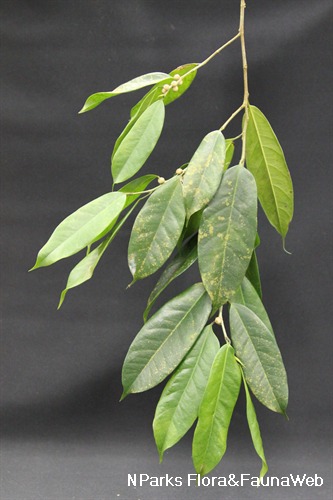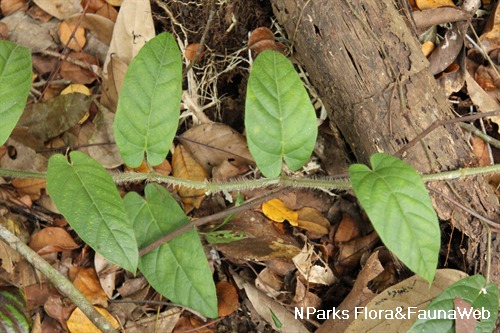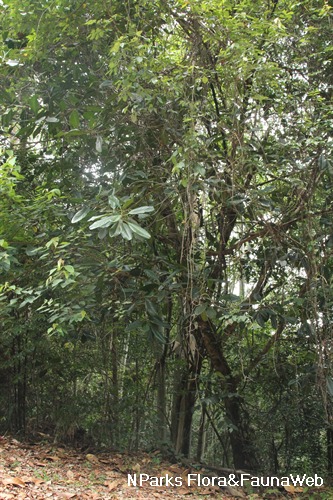
Back
Ficus deltoidea Jack
| Family Name: | Moraceae |
| Synonyms: | Ficus ovoidea, Ficus diversifolia |
| Common Name: | Mistletoe Fig, Mistletoe Rubber Plant, Rusty-leafed Bush Fig, Mas Cotek, Serapat Angin, Telinga Beruk, 金钱榕 |
Name
Classifications and Characteristics
| Plant Division | Angiosperms (Flowering Seed Plants) (Dicotyledon) |
|---|---|
| Plant Growth Form | Shrub |
| Mode of Nutrition | Autotrophic |
| Maximum Height | 1.8 m to 7 m |
| Maximum Plant Spread / Crown Width | 1 m to 3 m |
Biogeography
| Native Distribution | Malaysia, Indonesia, Southern Philippines |
|---|---|
| Local Conservation Status | Native to Singapore (Critically Endangered (CR)) |
Description and Ethnobotany
| Growth Form | It is an evergreen epiphyte or small shrub, up to 3 m tall. |
|---|---|
| Foliage | Its alternate, stalked leaves have thick leathery leaf blades that are mostly obovate, and 1–25 by 0.5–14 cm. Its leaf blades also have lateral venation that curves and joins near the leaf margins. |
| Flowers | It is a dioecious species, with male and female flowers borne on separate plants. Its flowers are enclosed within a specialised structure known as the syconium (fig). |
| Fruit | Its syconia (figs) are round to oblong, 4–15 mm wide, and ripen from yellow to orange, or red to dark purple. |
| Habitat | It grows as an epiphyte or terrestrial plant in the lowlands to mountains up to 3,200 m altitude. It also grows in thickets and scrub on sandy soil, or on rocks in coastal areas. It occurs locally at Pulau Ubin. |
| Associated Fauna | Its figs are eaten by birds and the flowers are pollinated by fig wasps. |
| Cultivation | Propagate by stem cuttings. Apply a root hormone to the cut ends and gently warm the pot to promote rooting. This species grows slowly. It can grow in most types of soil (including saline soils), but the soil must have good drainage. It does best in warm temperatures, humid environments and smaller pots in which it can be rootbound. Re-pot when roots have grown through the drainage holes. For indoor plants, feed biweekly with a half-strength fertilizer and allow the top inch of soil to dry before re-watering. Too much water will cause plants to lose their lower leaves. Indoor plants potted in a large container will reach a height of 1 m. |
| Etymology | The genus name "Ficus" is Latin for fig or fig tree. The species epithet "deltoidea" refers to how the leaf shape often resembles the Greek letter delta. The common name "Mistletoe Fig" is a reference to the plant's epiphytic growth habit on trees which is similar to mistletoe plants. |
| Ethnobotanical Uses | Medicinal: It is reputedly used for regulating blood pressure, womb contraction after delivery, reducing cholesterol and blood sugar levels. It is also used in the treatment of leucorrhoea, migraines, nausea, joint pains, pain from piles, removal of toxins, delaying menopause, and improving blood circulation. Its derived products are sold in the form of capsules, coffee, extracts, herbal drinks, and massage oil for their respective health benefits. It is also taken as anaphrodisiac. A decoction of the leaves may be consumed as a tonic drink after labour. Others: The latex may have been utilised as fish poison. |
Landscaping Features
| Landscaping | It has small attractive leaves that are golden underneath. Its leaves are also considered as a symbol for good luck and are hence more readily available in nurseries to be sold as an auspicious plant of the Chinese. It is suitable as an outdoor border plant, or potted plant for semi-shaded areas indoors. |
|---|---|
| Desirable Plant Features | Ornamental Foliage, Ornamental Fruits |
| Landscape Uses | Container Planting, Interiorscape/ Indoor Plant, General, Suitable for Roadsides, Parks & Gardens, Small Gardens, Coastal, Suitable for Rooftops, Hedge / Screening, Skyrise / Balcony |
| Thematic Landscaping | Golden Garden |
Fauna, Pollination and Dispersal
| Fauna Pollination Dispersal Associated Fauna | Caterpillar Moth Food Plant, Bird-Attracting (Fruits) |
|---|---|
| Pollination Method(s) | Biotic (Fauna) |
| Seed or Spore Dispersal | Biotic (Fauna) |
Plant Care and Propagation
| Light Preference | Full Sun |
|---|---|
| Water Preference | Little Water |
| Plant Growth Rate | Moderate |
| Rootzone Tolerance | Saline Soils / Salt Spray, Drought Tolerant, Well-Drained Soils, Easy to Grow |
| Propagation Method | Seed, Stem Cutting |
Foliar
| Foliage Retention | Evergreen |
|---|---|
| Mature Foliage Colour(s) | Green, Yellow / Golden |
| Mature Foliage Texture(s) | Smooth, Leathery, Thick |
| Foliar Modification | Stipule |
| Foliar Type | Simple / Unifoliate |
| Foliar Arrangement Along Stem | Alternate |
| Foliar Attachment to Stem | Petiolate |
| Foliar Shape(s) | Non-Palm Foliage (Obovate) |
| Foliar Venation | Pinnate / Net |
| Foliar Margin | Entire |
| Foliar Apex - Tip | Rounded |
| Foliar Base | Acute |
| Typical Foliar Area | Notophyll ( 20.25cm2 - 45 cm2 ) |
| Leaf Area Index (LAI) for Green Plot Ratio | 4.5 (Shrub & Groundcover - Dicot) |
Floral (Angiosperm)
| Flower & Plant Sexuality | Unisexual Flowers , Dioecious |
| Flower Grouping | Cluster / Inflorescence |
|---|
| Flower Location | Axillary |
| Inflorescence Type | Syconium |
Fruit, Seed and Spore
| Mature Fruit Colour(s) | Red, Orange, Purple |
|---|---|
| Fruit Classification | Multiple Fruit |
| Fruit Type | Fleshy Fruit , Accessory / False Fruit (Pseudocarp) |
Image Repository
Others
| Master ID | 719 |
|---|---|
| Species ID | 2014 |
| Flora Disclaimer | The information in this website has been compiled from reliable sources, such as reference works on medicinal plants. It is not a substitute for medical advice or treatment and NParks does not purport to provide any medical advice. Readers should always consult his/her physician before using or consuming a plant for medicinal purposes. |










.jpg)